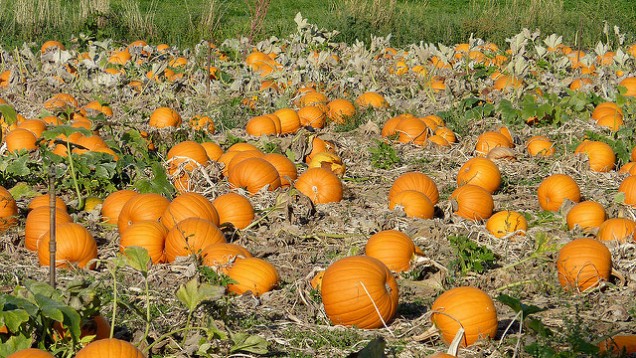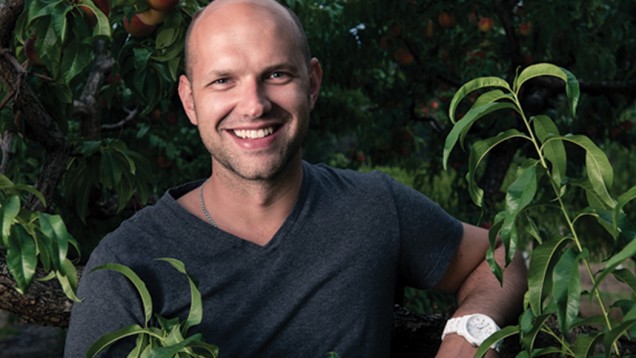
We Heart Local – #MiniRecipeBC Winners!
August 4, 2016
Harvest time: get the most out of BC’s best season with local fall festivals and more!
October 19, 2016
There’s nothing better than your first bite of a crisp BC apple or pear in September. We’re lucky to be able to get our favourite autumn fruits locally - but did you know that most of your BC tree fruit probably originated with one of just 500 grower families living and working in BC? We caught up with Chris Pollock, Marketing Manager for BC Tree Fruits, to chat about this amazing cooperative and what makes BC apples and pears so distinctive.
We Heart Local (WHL): What about BC’s climate makes it such an ideal place for tree fruits?
Chris Pollock (CP): The climate that we have in the Okanagan valley and the Similkameen valley does make it ideal to grow tree fruits. We’re probably the furthest north that you can grow tree fruits - but the mountains, the lakes, the soil, the landscape, and the weather in combination provides the ideal growing situation, for our tree fruits in particular. It definitely creates some challenges near the end of the apple season in terms of getting the fruit off the tree ripe enough before frost hits, but at least the last couple of years with the crops being early, that hasn’t been as much of a challenge for us. Having certain years be earlier than others is something that we’ve experienced for years, going back into the 50’s and 60’s. The fun part about this industry is there is no norm. Every year provides different challenges and different successes. It makes it... we’ll call it fun. It makes for a very unique career!
WHL: How many farming families are part of the co-op?
CP: We have just over 500 grower families that make up our cooperative, and that’s spread out across the Okanagan and the Similkameen valleys. There are growers that are outside of that, especially when it comes to the cherry growers, but for the most part [our co-op] makes up 80-85% of BC’s apple growers and then I’d say we have a third of the cherry growers.
WHL: Why is sustainability a key part of the tree fruit industry? Could you share any practices tree fruit farmers follow that they are really proud of?
CP: In terms of sustainability for growers and for our industry as a whole, you have to be progressive. In BC,[our viable growing space] sounds like a large area, but it’s not in terms of the acreage available to our growers. To give you a comparison to our neighbours down south, their orchards average hundreds of acres whereas ours average maybe 20 acres. So you don’t have the excessive land availability that our neighbours down south do.
So it goes back to being progressive in order to get the most fruit off your trees based on the acreage you have planted. [To do this], you do things like high density planting versus old style plantings. In high density planting, the trees’ height is controlled, they’re planted closer together, you have wires and posts that are used to hold them up, and you’re able to get more fruit per acre off the trees versus the old style plantings which have the larger trees. They still produce fantastic fruit but it takes longer to pick and you don’t get as much fruit per acre off the trees.
And then [being progressive] also goes into what you’re growing. When you’re planting new trees it takes about 3-5 years for you to actually get product off that tree. We as growers need to know what you as a consumer are going to want five years down the road in terms of older or newer varieties. So there’s a lot of investment made by our grower base, hoping there’s going to be a demand for that variety. There’s a lot to it - there’s a lot to growing fruit, to packing fruit, to storing fruit and to shipping fruit - and it’s fun because there is no normal year.
WHL: Are you able to speak a little bit about what’s currently popular with consumers versus vintage varieties?
CP: We’re not seeing as much consumer demand for traditional varieties like Red Delicious, Granny Smith, and Golden Delicious. [On the other hand], Ambrosia is a huge newer variety discovered in BC in the early 90’s. It continues to be a worldwide popular variety that’s not going away anytime soon. You’re also seeing varieties like Honey Crisp and Pink Lady from our growers - and there are also other varieties grown in the States and grown in New Zealand (like Jazz and the Pacific Rose) that are new. I think you’re going to see a trend where there’s re-plant taking place. For our industry in BC, the provincial and federal governments have come together to provide a re-plant program for our grower base because it is not cheap to re-plant orchards. So there’s money available for our grower base to apply to get funding from both governments in order to help cover costs to re-plant older varieties or to re-plant from different fruits over to apples or over to cherries. - When you’re doing so, you’d be planting varieties like Pink Lady, or Ambrosia, or Sweetheart or Staccato cherries, depending on where your orchard is located. You really have to be in it for the long haul in order to see the - pardon the pun - see the fruits of your labour come to fruition.
WHL: What should readers be looking for when they go shopping for BC Tree Fruits?
CP: Look for the Leaf! Seeing that BC Tree Fruit sticker, you understand that the fruit that you’re buying is going to be high quality, it’s going be grown locally by one of our 500+ grower families, it’s going to be food safe, it’s going to have gone through all of the necessary paths that the fruit takes from orchard to table.
Local consumer support is huge for the success of our cooperative. To use apples as an example - on average, let’s say we have some 2.8 to 3 million 40 pound boxes of apples. Our neighbours in the States - I mentioned their acreage being a lot higher - they average 120 million boxes of apples. You can see that there is no comparison in terms of volume, and there never will be. So we really strongly rely on consumer support and on consumers seeking out that leaf before anybody else or any fruit coming from any other countries. Buying local is obviously a way of life for most Canadians in terms of wanting to support local farmers and buy local produce that is grown close to home. We hope that consumers would want to support Canadian grown foods before any others. That’s a strong element of success for our cooperative.
WHL: We know that Anjou pears in Canada are grown exclusively in BC, and that Ambrosia apples originated here, are there any other tree fruits that enjoy a special BC connection?
Chris Pollock (CP): The climate that we have in the Okanagan valley and the Similkameen valley does make it ideal to grow tree fruits. We’re probably the furthest north that you can grow tree fruits - but the mountains, the lakes, the soil, the landscape, and the weather in combination provides the ideal growing situation, for our tree fruits in particular. It definitely creates some challenges near the end of the apple season in terms of getting the fruit off the tree ripe enough before frost hits, but at least the last couple of years with the crops being early, that hasn’t been as much of a challenge for us. Having certain years be earlier than others is something that we’ve experienced for years, going back into the 50’s and 60’s. The fun part about this industry is there is no norm. Every year provides different challenges and different successes. It makes it... we’ll call it fun. It makes for a very unique career!
WHL: How many farming families are part of the co-op?
CP: We have just over 500 grower families that make up our cooperative, and that’s spread out across the Okanagan and the Similkameen valleys. There are growers that are outside of that, especially when it comes to the cherry growers, but for the most part [our co-op] makes up 80-85% of BC’s apple growers and then I’d say we have a third of the cherry growers.
WHL: Why is sustainability a key part of the tree fruit industry? Could you share any practices tree fruit farmers follow that they are really proud of?
CP: In terms of sustainability for growers and for our industry as a whole, you have to be progressive. In BC,[our viable growing space] sounds like a large area, but it’s not in terms of the acreage available to our growers. To give you a comparison to our neighbours down south, their orchards average hundreds of acres whereas ours average maybe 20 acres. So you don’t have the excessive land availability that our neighbours down south do.
So it goes back to being progressive in order to get the most fruit off your trees based on the acreage you have planted. [To do this], you do things like high density planting versus old style plantings. In high density planting, the trees’ height is controlled, they’re planted closer together, you have wires and posts that are used to hold them up, and you’re able to get more fruit per acre off the trees versus the old style plantings which have the larger trees. They still produce fantastic fruit but it takes longer to pick and you don’t get as much fruit per acre off the trees.
And then [being progressive] also goes into what you’re growing. When you’re planting new trees it takes about 3-5 years for you to actually get product off that tree. We as growers need to know what you as a consumer are going to want five years down the road in terms of older or newer varieties. So there’s a lot of investment made by our grower base, hoping there’s going to be a demand for that variety. There’s a lot to it - there’s a lot to growing fruit, to packing fruit, to storing fruit and to shipping fruit - and it’s fun because there is no normal year.
WHL: Are you able to speak a little bit about what’s currently popular with consumers versus vintage varieties?
CP: We’re not seeing as much consumer demand for traditional varieties like Red Delicious, Granny Smith, and Golden Delicious. [On the other hand], Ambrosia is a huge newer variety discovered in BC in the early 90’s. It continues to be a worldwide popular variety that’s not going away anytime soon. You’re also seeing varieties like Honey Crisp and Pink Lady from our growers - and there are also other varieties grown in the States and grown in New Zealand (like Jazz and the Pacific Rose) that are new. I think you’re going to see a trend where there’s re-plant taking place. For our industry in BC, the provincial and federal governments have come together to provide a re-plant program for our grower base because it is not cheap to re-plant orchards. So there’s money available for our grower base to apply to get funding from both governments in order to help cover costs to re-plant older varieties or to re-plant from different fruits over to apples or over to cherries. - When you’re doing so, you’d be planting varieties like Pink Lady, or Ambrosia, or Sweetheart or Staccato cherries, depending on where your orchard is located. You really have to be in it for the long haul in order to see the - pardon the pun - see the fruits of your labour come to fruition.
WHL: What should readers be looking for when they go shopping for BC Tree Fruits?
CP: Look for the Leaf! Seeing that BC Tree Fruit sticker, you understand that the fruit that you’re buying is going to be high quality, it’s going be grown locally by one of our 500+ grower families, it’s going to be food safe, it’s going to have gone through all of the necessary paths that the fruit takes from orchard to table.
Local consumer support is huge for the success of our cooperative. To use apples as an example - on average, let’s say we have some 2.8 to 3 million 40 pound boxes of apples. Our neighbours in the States - I mentioned their acreage being a lot higher - they average 120 million boxes of apples. You can see that there is no comparison in terms of volume, and there never will be. So we really strongly rely on consumer support and on consumers seeking out that leaf before anybody else or any fruit coming from any other countries. Buying local is obviously a way of life for most Canadians in terms of wanting to support local farmers and buy local produce that is grown close to home. We hope that consumers would want to support Canadian grown foods before any others. That’s a strong element of success for our cooperative.
WHL: We know that Anjou pears in Canada are grown exclusively in BC, and that Ambrosia apples originated here, are there any other tree fruits that enjoy a special BC connection?
CP: There is the Summerland research centre, which is a government facility where they breed different varieties. Spartan, for example, is a variety that was developed at the Pacific Agriculture Research Centre in Summerland, and we also have multiple cherry varieties that were also bred there: Staccato, Sweetheart, and Skeena, I believe. In terms of having that BC flavour, those varieties started here. Ambrosia started as a stray seedling in Costen, making it a BC original. Also, MacIntosh apples: while they weren’t discovered here because of our climate, we’re one of the few regions that can grow them and grow them effectively. You don’t see MacIntosh apples grown in Washington State because it’s harder for them to grow, it’s a warmer climate. MacIntosh need those cooler nights in order to colour up and mature.
Feeling hungry for some tree fruits? Head to your local grocery store (you can tell which apples and pears come from BC because they carry the BC Tree fruits sticker) or farmer’s market. You can even pick your own: here are two great round-ups for orchards across BC and in the Okanagan that offer U-Pick options. Once you’ve picked your fill of apples and pears, check out these recipes for a tasty end to any autumn day:
Feeling hungry for some tree fruits? Head to your local grocery store (you can tell which apples and pears come from BC because they carry the BC Tree fruits sticker) or farmer’s market. You can even pick your own: here are two great round-ups for orchards across BC and in the Okanagan that offer U-Pick options. Once you’ve picked your fill of apples and pears, check out these recipes for a tasty end to any autumn day:
- Apple Chutney Stuffed Pork Chops
- Cornmeal and Pear-Crusted Halibut
- Ambrosia Apple and Quinoa Salad
- Apple Brown Betty
Photo credit: Courtesy of BC Tree Fruits